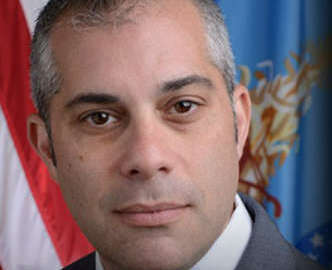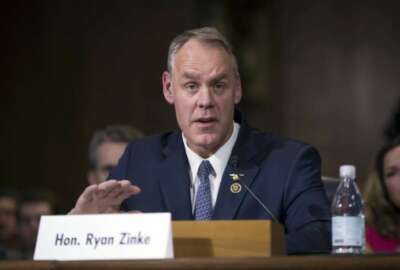 Exclusive
Exclusive Exclusive
Interior senior executives left in the dark amid reorg, reassignments
Senior executives at the Interior Department say recent reassignments have demoralized the SES corps and agency leadership has done little to involve them in pl...
Some of the Interior Department’s longest-tenured and most experienced career executives say they’re feeling undervalued and overlooked as the agency begins a major effort to restructure and reorganize.
Their criticisms come as Interior political leadership charges forward with a major reorganization effort that includes the reassignment of 30-to-50 senior executives back in June and another round of job transfers expected in the next few weeks.
Multiple sources say the new reassignments are expected to focus on filling current position gaps in the department.
One reason for the timing of the second round may be related to the arrival of David Bernhardt, who now is serving as Interior’s deputy secretary, several sources said. The Senate confirmed Bernhardt July 24.
But for several members of Interior’s Senior Executive Service, the reassignments themselves sting less than how the department is going about its decisions.
Several Interior sources told Federal News Radio that the most recent round of reassignments created a “chilling effect” in the department, and they fear how the reorganization effort will impact the workforce when the department’s executive cadre has had “absolutely no involvement whatsoever” in crafting the agency’s plans.
“[Secretary Ryan Zinke’s career] executive team, his folks that are running his bureaus, have had no input, no review and no consultation,” said one executive on the West Coast who received and accepted a reassignment and requested anonymity because the executive didn’t get permission to speak to the press.
There’s been “complete radio silence” from Interior leadership about its plans for the reorganization, said Joel Clement, who filed an official complaint to the Office of Special Counsel about his reassignment from the director of the Office of Policy Analysis to a senior adviser position at the Office of Natural Resources Revenue.
The West Coast executive said the White House received and approved Interior’s draft reorganization plan from June. All agencies have a September deadline to submit final versions of those plans, along with their fiscal 2019 budget requests.
The Interior Department declined to comment specifically on the executives’ criticisms and wouldn’t confirm or deny a second round of reassignments.
“The President signed an executive order to reorganize the federal government for the future and the secretary has been absolutely out front on that issue,” Interior spokeswoman Heather Swift wrote in an email to Federal News Radio. “In fact, he mentioned a departmentwide, front lines-focused reorganization on his first day address to all employees.”
But some senior executives say the lack of communication about Interior reorganization — coupled with the department’s recent round of SES reassignments — has them feeling demoralized.
“It’s like a morgue going into that building,” Clement said. “Everyone’s watching their back.”
Zinke has spoken of his desire to improve Interior’s results on the annual Federal Employee Viewpoint Survey and its rank on the Partnership for Public Service’s Best Places to Work list. Interior improved its employee engagement score slightly from 62 to 63 percent on the 2016 FEVS, and the department ranked 11th out of 18 large agencies on last year’s Best Places to Work index.
“No matter what we do, we have to subscribe and dedicate ourselves to be number one,” Zinke said, during a March 3 speech to employees. “I don’t want to be number two. As a SEAL, I try not to lose any battles, and I haven’t lost any. And I expect all of us not to lose.”
But the executives and experts say they doubt the department can achieve those goals in the current environment.
“When we don’t get involved in the decision-making, we get detailed, they seem to have no regard for our personal lives and our families,” the West Coast executive said. “[The secretary] talks about what he wants out of this organization, and I’m just like, ‘You are not going to get there, sir, when this is how you treat your employees’ and cause this kind of disruption and chaos within the federal ranks.”
The federal government, by its nature, is a collaborative process, said Jeri Buchholz, an independent consultant and former chief human capital officer for NASA. In her experience, new political leaders can often struggle to understand and promote a collaborative culture.
Strong political leaders find ways to include their career executives and use their ideas to achieve the administration’s priorities and projects. Others, she said, take a different approach.
“The executive gets told for all practical purposes, if not in reality, ‘Sit down and shut up,'” Buchholz said. “The executive’s response … is ‘OK, I can follow that order.’ They will take two steps back and they will be quiet. They won’t be counterproductive. They won’t be undermining the authority of the executive; they will simply be quiet. Decisions will get made and they won’t be speak up, because they have been told not to speak up. That’s where it gets difficult.”
Questions about SES reassignments
Both the West-Coast executive and Clement accepted their recent reassignments to other positions in other offices and bureaus. Like many other reassigned executives, their new roles vastly differ from the positions they once held and span other fields and areas of expertise.
Other executives received reassignments to new geographic locations. One senior executive, for example, was asked to move from a position in Washington, D.C. to another in Alaska.
Clement said the supervisors in his new office were just as surprised as he was to learn of his reassignment. He said he has hundreds of hours of training and staff time ahead of him in order to learn the ropes of his new job. It’s a costly and time-consuming process that will require a few trips to Denver, he added.
Clement hasn’t heard from Interior leadership or OSC about his official complaint.
Nor has he heard from Interior’s inspector general, after Senate Energy and Natural Resources Committee Ranking Member Maria Cantwell (D-Wash.) and seven others asked the IG to investigate the reassignments.
“Any suggestion that the department is reassigning SES employees to force them to resign, to silence their voices or to punish them for the conscientious performance of their public duties is extremely troubling and calls for the closest examination,” the senators wrote in a July 24 letter to Deputy IG Mary Kendall.
By design, the SES workforce is supposed to be a mobile corps of highly-experienced leaders.
Under Title 5 of the U.S. Code, agencies must give career SES a 15-day advance written notice for reassignments in the same commuting area and a 60-day advance notice for a move to a different geographic location. Senior executives cannot receive reassignments within the first 120 days of an agency head’s appointment, which typically gives new department leaders time to get acquainted with their career leaders.
Latest Management News
Interior spokeswoman Swift said SES moves are what’s best for the department.
“Senior executives are the highest paid employees in the federal government and signed up for the SES knowing that they could be called upon to work in different positions at any time,” Swift wrote. “Congress meant for the SES to be a mobile force that are capable of taking on different assignments to meet the needs of the agency. Personnel moves among the Senior Executive Service are being conducted to better serve the taxpayer and the department’s operations.”
Zinke told senators during a June 21 Appropriations Committee hearing that that the move to reassign an undetermined number of senior executives to new positions wasn’t nearly unprecedented.
“From what we can see, they followed the procedures,” said Bill Valdez, president of the Senior Executives Association. “They gave notice. They allowed for the rights that SES has to accept or deny the reassignment. Could it have been handled better? Perhaps, but it’s not something that is so unusual in the federal government.”
Other agencies also are shuffling their career executives to new positions. As Federal News Radio reported, the Agriculture Department transferred its chief information officer to be the deputy procurement executive. The transition is part of USDA’s major effort to reorganize management, including the deputy assistant secretary for management and possibly others in the CXO community.
Others are concerned by the decision to move Interior SESers.
Sen. Tom Udall (D-N.M.) questioned whether Interior’s reassignments had a disparate impact on executives close to retirement age.
Another Interior executive, who also received a reassignment letter and requested anonymity, said recent reassignments had a disparate impact on women and minorities in the department’s SES corps.
By this executive’s count, at least 29 of Interior’s 223 SES members received reassignment notices from Interior leadership in June. Among them, 13 are men and 16 are women. Of the 13 men, six are minorities and seven are white, the executive said.
Yet the Interior SES cadre is roughly 34 percent female and 66 percent male, according to the most recent numbers from the Office of Personnel Management.
And of the 148 men in the Interior SES cadre, 31 percent have identified themselves as minorities, while 68 percent are non-minorities.
Whether the moves were intentional or not, the executive said the reassignments sent the wrong message.
“It’s making people afraid of even applying in an SES position and even being in the SES,” the executive said.
Both reassigned Interior executives said they knew when they joined the SES that transitioning to new positions is often part of the job.
But one said the department’s most recent round differed from previous direct reassignments.
The executive described a prior direct reassignment as a collaborative and transparent process. The executive discussed the new job with agency leadership and was given a trial period to act in the position.
“I just never really guessed that anything like this would happen, but you sign that form and that’s exactly what it says,” the source said. “You can be reassigned at any time for any reason with two weeks notice, and you sign that form. It’s just that it’s never happened like this before. I don’t think anybody was really expecting this sort of level of movement.”
Involvement in reorganization
Career leaders at some agencies have been involved in developing their organization’s government reform plans, said Valdez, who described employee and leadership collaboration in the government reorganization process as a “mixed bag.”
Valdez said the Small Business Administration and departments of Health and Human Services and Homeland Security were model agencies that solicited ideas and feedback from every corner of their workforces.
But other agencies, he said, have taken a different approach.
“We’ve heard from other agencies that [career executives] have been cut out, and that is unfortunate, because some agencies have reported to us that they’ve sent in information for the request of the senior political leadership, in terms of budget plans and other kinds of documents, but have received no feedback [and] no understanding of whether or not recommendations were accepted,” he said.
Organizations that fail to gather feedback from top executives and their employees during a major restructuring are more likely to set themselves up for failure, said Joe Abusamra, vice president of product marketing of Acendre, a talent management company.
“These people know the inner-workings, they know how things operate, they know what can be done, what can be done quickly [and] what might take more time,” he said. “If you’re not getting that input, it’s really going to be a challenge to have something be successful.”
Organizations in the middle of a major restructuring should be as open and transparent as possible to their employees about what they know — and what they don’t know — about their reorganization plans, Abusamra said. With little to no communication, rumors start flying, he added.
“If people think or know … that there’s going to be restructuring, that just takes so much energy and oxygen from the workings of the organization,” Abusamra said. “People start to think about what might happen, what will happen and they’ll spend a good time worrying about that and talking about that and discussing that among themselves.”
Clement said he feels different now that he’s spoken out and filed a complaint with OSC. He said he hopes his disclosure will encourage others to speak up.
“We need to find that voice again,” he said. “The civil service has been silent for far too long.”
Yet for the SES, voicing personal opinions isn’t typically part of the game, Buchholz said.
“When you are a part of the executive team, whether you feel welcome in that team, whether you agree with the decision that has been made, whether you are heard or not, when it is your job to execute a decision that has been made, you do not voice your personal opinion about that decision,” she said. “If you feel that you can no longer serve because what you’re being asked to do is so contrary to how you feel about a particular issue personally, then it’s time for you rethink your role in the organization.”
Both reassigned senior executives, who have decades of government experience and several years in the SES, acknowledged they have a limited voice. Both accepted their reassignments; they chose not to resign.
“We’re all good soldiers and we will do what the new administration asks us to do,” one of the reassigned executives said. “We will stand up and salute and get it done, and that’s our job. Even more importantly as executives, our job is to carry that message from the White House, from the secretary and make sure it happens on the ground. They want to see efficiency and effectiveness and cost savings to the taxpayers, but you don’t do that by yanking your senior leadership around like this. We’re the ones that you want to be the most loyal. We’re the ones that are going to make sure that your agenda happens on the ground, and I just don’t think they get that.”
Copyright © 2024 Federal News Network. All rights reserved. This website is not intended for users located within the European Economic Area.
Nicole Ogrysko is a reporter for Federal News Network focusing on the federal workforce and federal pay and benefits.
Follow @nogryskoWFED





